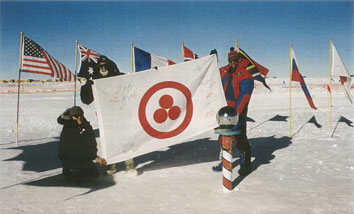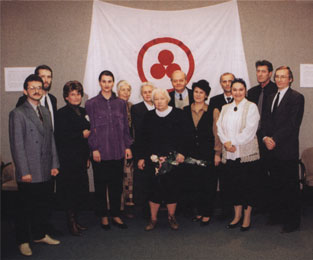| printer friendly | |||
|
|||
 | |
| V. Chukov (Russia), V. Drabo (Belarus),
and worker of the American Pole Station “Amundsen-Scott” with the Banner of Peace on the South Pole. January 8, 2000. |
The Banner of Peace became the symbol of Roerich’s Pact. Three small circles within a large one, signifying the unity of the past, present, and future in the space of Eternity and symbolizing the cosmic law of cultural succession. Banners of Peace, the International signs of evolution, are raised all over the world in those places where Culture is protected. The Banner of Peace has flown around our planet in a cosmic spacecraft, has waved at the North and South poles, has taken part in many major cultural events.
In 1930, even before the Pact for the protection of culture was signed, N. Roerich wrote: “This plan (The Pact for the Protection of Culture – L. Sh.) provides for a special flag that will be respected as international neutral territory; this banner must be raised above museums, cathedrals, libraries, universities, and other centers of culture.”[20, p.103]
I would like to present some quotations regarding the Banner of Peace by the cosmonauts who raised the banner above the planet Earth.
A. Balandin: “I think that the more often people come into contact with the Banner of Peace, the more often, before doing or saying something, they will consider whether or not they should really do it. Maybe, our spirituality, and just good, will be revived through this.”[21]
A. Soloviev: “We are convinced that only on the basis of partnership and collaboration can a beautiful future be constructed in the 21st century. [...] Culture is the basis for the building of a common home for mankind. Toward this goal, Russian and International public organizations have started the cosmic project “Banner of Peace.”[22, p.104]
Michael Foal, American astronaut: “We have raised the Banner of Peace into the Cosmos in order to remind all people of our global responsibility for the fate of humanity and the planet. [...] Man’s travels into the cosmos [...] are the first steps in a new, single, cosmic culture, the symbol of which is the Banner of Peace.”[23, p.104]
P. Vinogradov: “We have raised the Banner of Peace above the planet so that Culture may forever outstand war and hostility on our planet. We call for the construction of new spiritual, scientific, and artistic collaboration of all people and peoples of the Earth.”[24, p.104]
When you listen to these speeches or read them, you start to understand very well that those who have been into outer space better than anyone else understand its essence – the construction of a new World, the creation of a new Culture. The Living Ethics, which contains a system of cognition of a new cosmic mentality, also functions under the Banner of Peace and its symbols. “Let us purposefully construct,” Helena Roerich wrote, “a stronghold of culture – the knowledge of the Living Ethics and beauty. Knowledge and Beauty are the basis and the crown of cosmic evolution.”[25, p.59]
Unfortunately, under the contradictory circumstances of our existence, far fewer than the majority understand the significance of the “crown of cosmic evolution” and do not recognize the beginning of the epoch of new cosmic thinking.
“There will be a time,” Helena Roerich predicted, “when the Banner of Peace, the Banner of Culture will cover the whole world.”[26, p.102] As known, a lot has already been done for it. And still a lot is left to be done. This process is not easy. Not everybody is aware that the Banner of Peace is the symbol of culture and cosmic evolution.
“The history of the Pact,” Helena Roerich pointed out, “is a very instructive book in which the sides of light and darkness will be very clearly marked, and peoples will see for themselves that all that was constructive, all that had a future ahead of it, supported the Pact’s ratification and the acceptance of the Banner. The Banner of Peace is a great touchstone for humanity’s mentality.”[27, p.351]
 | |
| Banner of Peace in the RF State Parliament (Duma) |
The State Duma of the Federal Assembly of Russia turned out to be incapable of passing the test on this touchstone. The Banner of Peace hung in the Duma beginning in 1995, giving a certain hope that this important state body would not only comprehend the essence of this symbol, but would also pay attention to the necessity of protecting culture. For almost ten years, Duma deputies contemplated this Banner, listened to lectures on culture and about Roerich’s Pact. All this did not have any noticeable impact on the Duma. In 2004 the Banner of Peace was removed. This demand was instigated by the Duma deputy, the journalist Kroutov. But it does not matter who instigated it. There are still many such Kroutovs on the Earth. It is they who embody the dark rows of the adversaries of culture, it is they who do not pass the test for a worthy level of morality. Those who hurried to remove this Banner without even the formal decision of the Duma itself proved to be irresponsible and ignorant. Those who did not speak against Kroutov, who called the Banner of Peace “the sign of Satan” turned out to be irresponsible too. The deputies incurred shame on themselves in removing the Banner of Peace. It so happened that in the autumn of the same year, during the birthday celebration of the outstanding artist and philosopher Svetoslav Roerich, the Banner of Peace was handed by cosmonaut V. Afanassiev to the Vice-Speaker of the Indian Parliament in Delhi, and it is now held in the Parliament of India. It is India, where our compatriots Roerichs worked and created for many years, that passed the test for culture, unlike the State Parliament of Russia. During celebrations dedicated to S. Roerich’s birthday, two people representing the International Center of the Roerichs, the ICR President Y. Vorontsov and L. Shaposhnikova, were received by Prime Minister of India Manmohan Singh and Foreign Minister Natvar Singh. Both, when speaking of the Roerichs, called them a bridge between the culture of India and Russia. Is such deep penetration into the essence of the Roerichs’ cultural activities characteristic of our high officials? I am afraid not. The attitude toward the Banner of Peace in our Duma revealed another situation. The Duma and its deputies do not take much interest in what is happening beyond their walls, do not pay attention to what is said and written beyond their space. If it were not so, then hardly would the Banner of Peace – the symbol of world culture – have be driven out of the Duma. And it was only the Deputy Chairman of the Committee for Culture Yelena Drapeko who forwarded a letter to the State Duma Speaker B. Gryzlov with a protest against bureaucratic arbitrariness. Touching upon the history of Roerich’s Pact and the Banner of Peace, Yelena Drapeko wrote: “The significance of the Banner of Peace is the fact that, by way of the protection of human creations, respect for the spiritual values by which all of mankind lives is laid into the consciousness of the masses and the oncoming generation. [...] I believe it fit to note that, despite A. Kroutov’s personal opinion, which is specified in his speech dedicated to the Banner of Peace, the significance of the latter is not at all diminished in the eyes of the world’s public. The Committee for Culture [...] receives many appeals from public organizations and citizens who are insulted by the words of the said deputy and by the fact that the Banner of Peace, on the pretext of repair or a change in exhibition, was removed from the session room lobby on the eve of the 70th anniversary of the Pact of Peace.
On February 20, 2005, in the Moscow House of Journalists, a public conference on the subject “Culture Against Terrorism” was held, in which was discussed the situation with the Banner of Peace and was adopted an appeal to the State Duma drawing its attention to the necessity of keeping this symbol of humaneness, morality, and the protection of cultural values in the building of the Russian Parliament. The presence of the Banner of Peace in the Duma will undoubtedly create the necessary ground and atmosphere for the development and strengthening of the great idea of the protection of cultural values, so clearly necessary for the physical and spiritual health of mankind.
More than half a year has passed after that shameful anti-cultural act in the State Duma of Russia, but nothing has changed. The Banner of Peace is still not there. There is no way of thinking that the letter did not reach Gryzlov. One might rather think of another thing – of the Parliament speaker’s alienation from the issues of culture, complete deafness in this respect, and lack of understanding of the role of culture in our society. This is probably the worst thing. And as long as the powers that share Gryzlov’s level of mentality allow Kroutovs and Kourayevs to implement their anti-cultural ideas, we will not be able to assert and protect the heart of our being – Culture.
“Be ready to respond with dignity to all ignoramuses and destroyers of Culture! The Banner of Peace and Culture must be understood now as a great symbol,” Helena Roerich wrote.
On April 15, 1935, when Roerich’s Pact for the protection of Culture was signed by the heads of a number of states, N. Roerich once again reminded everyone of the significance and the evolutionary essence of the Banner of Peace, the symbol of this Pact. “Let the Banner of Peace stream above the centers of Light, above the shrines and citadels of the beautiful. Let it stream above all deserts, above lonely secret abodes of Beauty, so that deserts burst into blossom from this sacred grain. The Banner is raised. It will not be lowered in the spirit and the heart. With the lighted fire of the heart, the Banner of Culture will blossom. So may it be!”
“So may it be!” we shall repeat after our great compatriot who brought to our Planet the knowledge of Culture and Cosmic evolution so needed by us. And let the Banner of Peace – the symbol of Culture and new cosmic mentality – lead us forward, to a new World of high spirituality, expanded consciousness, and flourishing Culture.”
|
|
||
|
||
